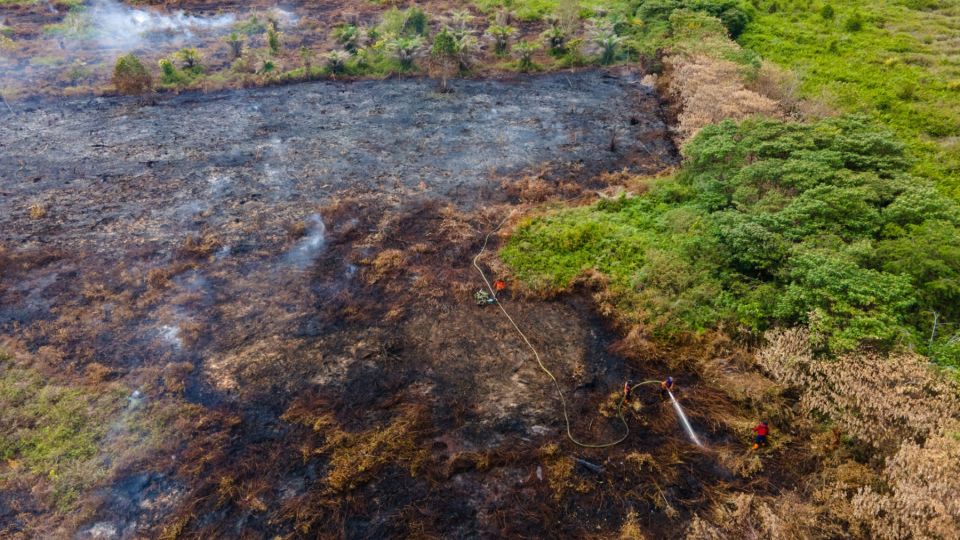September 19, 2025
JAKARTA – While Indonesia is experiencing a “wet dry season” with relatively high rainfalls, a recent independent analysis has revealed an increasing rate of forest and land fires across the country, particularly in oil palm plantation and energy concessions.
The analysis, launched by Jakarta-based environmental group Madani Berkelanjutan, found at least 218,000 hectares of land and forest, or an area larger than three Jakartas, have indications of being burned down between January and August.
Almost 100,000 ha were engulfed by fire in July alone, nearly twice the area burned in July 2023 when the country was hit by the El Niño weather phenomenon which resulted in a prolonged, hotter dry season.
Of the total figure, around 42 percent, or 80,000 ha, of burned land is located in concession areas linked to oil palm plantations, oil and gas industries and mineral mining.
For the analysis, Madani analyzed satellite imageries to monitor hotspots, or areas recorded over having higher temperatures compared to their surroundings. The similar method is also used by the Forestry Ministry to monitor potential forest fire sites for its official wildfire monitoring platform Sipongi, which recorded 6,000 ha less burned land than Madani in the same period.
Indonesia typically enters the dry season in April, with the month often marked with increasing rates of forest and land fires due to greater exposure to heat and strong winds. But this year, the archipelago saw a shorter and wetter dry season, with rainfall intensity relatively stable and increasing over the past few months.
“This further supports that wildfires have increasingly become anthropogenic or human-made, with more fires detected in concession areas,” Madani analyst Fadli Ahmad Naufal said on Wednesday.
Read also: Wildfires sweep through multiple regions in Sumatra
Another environmental group Pantau Gambut also recorded at least 23,600 ha of peatland were damaged by fires in July alone. Most of the fires were found in oil palm concession areas in West Kalimantan and Riau.
Peatland ecosystems in various parts of the country are often drained to make way for various plantations, such as oil palm. Dried peatland is highly flammable and can be ignited naturally or by human activities.
Based on the satellite analysis and combined with ground monitoring on hotspots, the group concluded most fires in concession areas were possibly ignited on purpose and highly “linked to industrial uses”, said Pantau Gambut analyst Juma Maulana.
Mostly human-made
The Forestry Ministry acknowledged most of the forest and land fires were anthropogenic, with lands often ignited deliberately.
“The extreme weather condition of hotter temperatures was also an important factor that exacerbated forest and land fires in the country, causing flammable materials to burn easily,” said Thomas Nifinluri, the forest and land fire control director at the Forestry Ministry.
But he claimed the wildfire trend in 2025 has so far been declining.
Between January and August, Indonesia saw a 25-percent decline in forest and land fires compared to the same period in 2023, when more than 1.1 million ha were burned due to the prolonged dry season.
Thomas added authorities had launched efforts to reduce the number of fire incidents across the country, including through law enforcement.
In August, the ministry sealed a dozen companies in West Kalimantan, Riau and South Sumatra for allegedly causing wildfires in their concession lands. The Forestry Ministry pledged to punish all companies found to be guilty of burning their lands without any lenience.
Thomas also cited the role of the forest and peatland coordination desk under the Office of Coordinating Politics and Security Minister that served as a forum where various ministries and state institutions coordinate in anticipating the fires.
Read also: Govt to revoke permits of firms found to cause wildfires
Indonesian Oil Palm Association (GAPKI) chair Eddy Martono claimed to have received no report of fires in concession areas of its 752 affiliated palm oil companies.
“Even if there’s a single hotspot, we would have been directly scolded by the government,” Eddy said on Wednesday, adding GAPKI had been working closely with authorities to prevent wildfires.
While most parts of Indonesia are forecasted to experience a wetter rainy season until April 2026, the Meteorology, Climatology and Geophysics Agency (BMKG) warned wildfires could still occur during the seasonal transition period between September and November.
The weather agency pointed to East Nusa Tenggara (NTT), West Nusa Tenggara (NTB) and several parts of Sumatra as regions still facing the risk of forest and peatland fires for the rest of the year.


